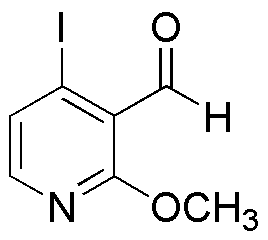3-Formyl-4-iodo-2-methoxypyridine is widely utilized in research focused on:
- Synthesis of Pharmaceuticals: This compound serves as a key intermediate in the development of various pharmaceuticals, particularly in the synthesis of novel anti-cancer agents.
- Organic Electronics: It is used in the fabrication of organic light-emitting diodes (OLEDs), enhancing the performance of display technologies.
- Biochemical Research: The compound is valuable in studying enzyme interactions and can be used to design inhibitors for specific biological pathways.
- Material Science: It is applied in creating advanced materials with unique properties, such as improved conductivity and stability for electronic applications.
- Analytical Chemistry: The compound can be utilized as a reagent in various analytical techniques, aiding in the detection and quantification of other substances.
General Information
Properties
Safety and Regulations
Applications
3-Formyl-4-iodo-2-methoxypyridine is widely utilized in research focused on:
- Synthesis of Pharmaceuticals: This compound serves as a key intermediate in the development of various pharmaceuticals, particularly in the synthesis of novel anti-cancer agents.
- Organic Electronics: It is used in the fabrication of organic light-emitting diodes (OLEDs), enhancing the performance of display technologies.
- Biochemical Research: The compound is valuable in studying enzyme interactions and can be used to design inhibitors for specific biological pathways.
- Material Science: It is applied in creating advanced materials with unique properties, such as improved conductivity and stability for electronic applications.
- Analytical Chemistry: The compound can be utilized as a reagent in various analytical techniques, aiding in the detection and quantification of other substances.
Documents
Safety Data Sheets (SDS)
The SDS provides comprehensive safety information on handling, storage, and disposal of the product.
Product Specification (PS)
The PS provides a comprehensive breakdown of the product’s properties, including chemical composition, physical state, purity, and storage requirements. It also details acceptable quality ranges and the product's intended applications.
Certificates of Analysis (COA)
Search for Certificates of Analysis (COA) by entering the products Lot Number. Lot and Batch Numbers can be found on a product’s label following the words ‘Lot’ or ‘Batch’.
Número de catálogo
Número de lote/lote
Certificates Of Origin (COO)
This COO confirms the country where the product was manufactured, and also details the materials and components used in it and whether it is derived from natural, synthetic, or other specific sources. This certificate may be required for customs, trade, and regulatory compliance.
Número de catálogo
Número de lote/lote
Safety Data Sheets (SDS)
The SDS provides comprehensive safety information on handling, storage, and disposal of the product.
DownloadProduct Specification (PS)
The PS provides a comprehensive breakdown of the product’s properties, including chemical composition, physical state, purity, and storage requirements. It also details acceptable quality ranges and the product's intended applications.
DownloadCertificates of Analysis (COA)
Search for Certificates of Analysis (COA) by entering the products Lot Number. Lot and Batch Numbers can be found on a product’s label following the words ‘Lot’ or ‘Batch’.
Número de catálogo
Número de lote/lote
Certificates Of Origin (COO)
This COO confirms the country where the product was manufactured, and also details the materials and components used in it and whether it is derived from natural, synthetic, or other specific sources. This certificate may be required for customs, trade, and regulatory compliance.


